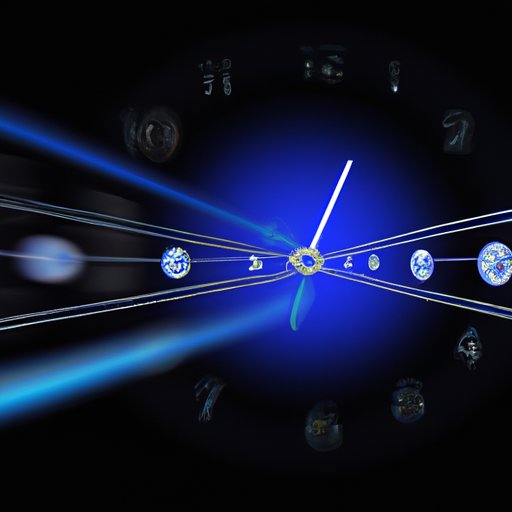Introduction
The term “light year” is often used in science fiction and astronomy to describe incredibly long distances, but what does it actually mean? A light year is a unit of length that measures the distance light travels in one year, approximately 9.46 trillion kilometers (5.88 trillion miles). But how long does it take to travel a light year? In this article, we will explore this question from the perspectives of physics, astronomy, and mathematics.

Explaining the Physics of Light Years
In order to understand how long it takes to travel a light year, we must first understand the physics behind it. Light speed, or the speed at which light travels, is the fastest speed known in the universe and is the basis of our understanding of light years. It is so fast that it is impossible for any object with mass to reach it, as the energy required would be infinite. Light moves at 299,792,458 meters per second, which means that a light year is equal to the distance light travels in one year.
To put this into perspective, if you were to travel at the speed of light, it would take you 8 minutes and 20 seconds to get to the sun, 4 years to get to the next closest star system, Alpha Centauri, and over 27,000 years to traverse the entire Milky Way galaxy. As you can see, light years are incredibly vast distances, making them difficult to travel in any reasonable amount of time.

Calculating the Distance and Time Needed to Travel a Light Year
There are several ways to calculate the distance and time needed to travel a light year. The most basic way is to simply multiply the speed of light by the number of seconds in a year. This will give you an estimated distance of 5.88 trillion miles. To find out how long it would take to travel this distance, you can divide the distance by the speed of light.
For example, if you wanted to travel a light year at the speed of light, it would take you 31,557,600 seconds, or 365.25 days, to do so. If you wanted to travel a light year at a slower speed, say 10% of the speed of light, it would take you 315,576,000 seconds, or 3,652.6 days, to do so.
Astronomy 101: What is a Light Year and How Long Does it Take to Reach?
A light year is a unit of measurement that describes the distance light travels in one year. It is equal to 9.46 trillion kilometers (5.88 trillion miles). To travel a light year at the speed of light would take 365.25 days, or 31,557,600 seconds. At a slower speed, such as 10% of the speed of light, it would take 3,652.6 days, or 315,576,000 seconds.

The Journey of a Light Year: An Overview of Time and Space
When considering the journey of a light year, it is important to remember that time and space are intertwined. As Albert Einstein famously said, “Time and space are modes by which we think and not conditions in which we live.” This means that time is relative to the observer and can be affected by the speed at which they are traveling. Therefore, when calculating the time needed to travel a light year, it is important to consider both the speed of the traveler and the effects of gravity on their journey.
The Fascinating World of Light Years: How to Measure Distance and Time in Space
There are several ways to measure distance and time in space, such as using astronomical units, parsecs, or light years. Astronomical units measure distance in terms of the average distance between the Earth and the Sun, while parsecs measure distance in terms of the angle subtended by a star at a distance of one parsec from Earth. Light years measure distance in terms of the amount of time it takes light to travel a certain distance.
When measuring time in space, it is important to remember that time passes differently depending on the speed of the observer. For example, if an observer is traveling close to the speed of light, then time will pass more slowly for them than for someone who is stationary. This phenomenon is known as “time dilation” and it can have a significant effect on the calculation of the time needed to travel a light year.
Conclusion
In conclusion, a light year is a unit of length that measures the distance light travels in one year, approximately 9.46 trillion kilometers (5.88 trillion miles). To travel a light year at the speed of light would take 365.25 days, or 31,557,600 seconds. At a slower speed, such as 10% of the speed of light, it would take 3,652.6 days, or 315,576,000 seconds. When calculating the time needed to travel a light year, it is important to consider both the speed of the traveler and the effects of gravity on their journey. From the structure of a light year to the fascinating world of time and space, exploring the journey of a light year is truly a captivating endeavor.
(Note: Is this article not meeting your expectations? Do you have knowledge or insights to share? Unlock new opportunities and expand your reach by joining our authors team. Click Registration to join us and share your expertise with our readers.)
